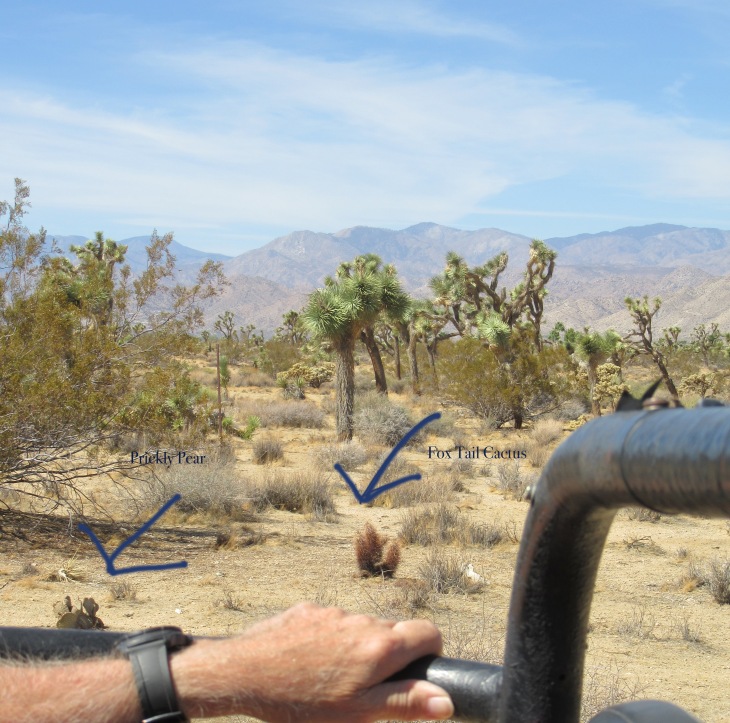In late September I had the chance to go to the Mojave and Colorado Deserts by way of Joshua Tree National Park in California. Long a fan of and fascinated by desert habitat, I jumped at the chance to take a Hummer tour of this unique ecosystem.
My 6th grade science fair project was on Cacti. Unbelievably, I still have one of the reference books I used. I also had seeds, and a mini-terrarium type garden displaying different types of cacti. When I was young, I fantasized about living in Arizona, near the desert and possibly having one of the large Saguaro Cactuses growing in my yard! It makes me laugh to know that other than flying to Phoenix a couple of times, I’ve never stayed in Arizona. (But, I’m working on that future trip!)
As I started to lead a garden club for elementary students, we needed topics which we could cover in the winter, as our meetings kept us inside during some of the most frigid days of the year. I ended up coming up with a variety of ideas that could be explored with students inside and one of them was Cacti!
Over the years, I’ve accumulated information on Cactuses and more recently, succulents (which is fodder for another post). Interesting to note is that almost everywhere I’ve travelled, I’ve been able to spot one genus of cacti, that of the prickly pear (opuntia) variety! We even have prickly pears that tolerate our harsh Wisconsin winters! A house down the road from us has one that grows in their front garden. And, the Sand Prairie, a few miles from my house also has prickly pears growing natively in this tract of protected land. Other places I’ve been able to spot prickly pears is on the sub-tropical island of Bermuda, on the side of the busy highway near San Diego, California, and even in Hawaii. They are a versatile species, virtually known to grow in every U.S. state and Canada!
But, after a while it seems that if you’ve seen one prickly pear, you’ve seen them all! So, on my trip to one of the great American Southwest deserts, I was hoping to spot more than this familiar variety.
Sure enough, I noted some large specimens of barrel cacti. But, unfortunately, these were just in a garden on the grounds of the resort where I stayed.
Upon arrival to the desert, I was struck by the brown-ness of it all. Arid. Dry. Color-less.
I missed the verdant hills and valleys we call coulees back in Wisconsin. From the air, the Southwest might have well been another planet!

The Joshua Trees provided the most color in this National Park as they reached up with their dark green needle like leaves, seemingly wanting to touch the crystal clear blue sky!

I was able to learn what a Teddy Bear Cholla ( Cylindropuntia bigelovii) Cactus looked like from this trip. Unlike what its name implies, the cactus will leave you spotted with burrs if one brushes too close. There it is, front and center, in the photo below! Watch out for that one!

I also got to glimpse a Foxtail Cactus from the Hummer, or it was identified as such by our Hummer Driver/Guide. Apparently, this variety is of conservation concern and only grows in the Mojave Desert. As you might guess, color and shape seem to imply its name. Oh, and I just noticed, there is a Prickly Pear nearby! I guess I still get a thrill from seeing them in a location new to me!


We also saw creosote bushes, and mistletoe, and lots of yucca. But, most prevalent, as the name of the park suggests were the unique Joshua Trees. On the way back to town, I spotted a Saguaro Cactus (I think it was real) growing on the side of the road. It was an unusual spot, but must have been there for a while because it had begun to sprout “arms.”

I enjoyed meeting new varieties of cactus on my trip to the desert. Now, I just have to get that trip to Arizona planned!
Cacti are wonderful plants to share with children, if they are old enough to heed warnings not to touch. Cacti have so many examples of adaptation, and ways to conserve water that can lead to some fascinating discussions!
Do you have a favorite cactus or place to view cacti? Let me know in the comments!



I enjoyed reading your cacti story. Joshua Tree is on our list of parks to visit in the next year, and from your photos, I’m excited. 🙂
LikeLiked by 1 person
Thanks! I would highly recommend a trip to Joshua Tree NP. It was fascinating! I’d like to go back but at nighttime!
LikeLiked by 1 person
Interesting…why at night? When we go we will camp a few nights. 🙂
LikeLiked by 1 person
Oh, I would definitely go back during the day, too. But, I found myself wondering how clear the skies must be there at night and how wonderful to be able to capture that image in my mind, if not with a camera!
LikeLike